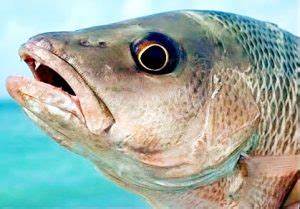
Mangrove Snappers, scientifically known as Lutjanus griseus, are among the most popular saltwater fish. They are highly valued for their adaptability, challenging nature for anglers, and delightful taste. Found in coastal and mangrove-rich regions, they serve as both ecological regulators and prized catches for fishing enthusiasts. This guide provides detailed insights into Mangrove Snappers, including their characteristics, habitat, diet, and more, ensuring all your questions are answered.
What Does a Mangrove Snapper Look Like?
Physical Appearance and Key Characteristics
Mangrove Snappers are medium-sized fish with a sleek, streamlined body that helps them navigate swiftly in water. Their coloration is typically gray or reddish-brown with a shimmering hue that intensifies under sunlight. They have sharp teeth and large, prominent eyes that enhance their hunting capabilities, making them efficient predators.
Juveniles often have vertical dark stripes along their bodies, providing camouflage in mangrove roots and seagrass beds. As they mature, these stripes fade, and their body gains a more uniform color.
Difference Between Juvenile and Adult Mangrove Snappers
Juvenile Mangrove Snappers are smaller and more vividly patterned than adults. These patterns allow them to blend with their surroundings to avoid predators. Adults grow larger, ranging between 10–20 inches, and their coloration becomes more subdued to help them remain inconspicuous in deeper waters.
Where Do Mangrove Snappers Live?
Habitat and Geographic Distribution
Mangrove Snappers thrive in warm, tropical, and subtropical regions. They are primarily found in coastal waters, mangrove forests, estuaries, and coral reefs. Mangroves provide them with abundant food, shelter, and breeding grounds. Their adaptability also allows them to venture into offshore waters as they grow.
They are prevalent in the Gulf of Mexico, the Caribbean Sea, and along the Atlantic coast of North and South America. In mangrove ecosystems, they coexist with other marine species, contributing to the diversity and balance of the habitat.
Role in Marine Ecosystems
Mangrove Snappers play a significant role in maintaining ecological balance. As predatory fish, they regulate the population of smaller fish and crustaceans, ensuring the health of marine ecosystems. Their presence also supports the food chain by serving as prey for larger species.
What Do Mangrove Snappers Eat?
Mangrove Snappers are opportunistic feeders, consuming a diverse diet to sustain their energy requirements. Their primary diet consists of crustaceans, such as shrimp and crabs, small fish, and squid. Juveniles primarily feed on smaller prey like plankton, while adults actively hunt for larger prey in deeper waters.
Their feeding behavior is influenced by their habitat. For instance, in mangroves, they consume organisms hiding in roots, while in coral reefs, they adapt to hunting fish or mollusks available in the area.
Why Are Mangrove Snappers Popular Among Anglers?
Fishing Techniques and Tips
Mangrove Snappers are highly sought after by anglers due to their strength and agility. For beginners, using live bait like shrimp, small fish, or squid can yield great results. Lightweight rods and reels are ideal for inshore fishing, while heavier gear is recommended for offshore excursions.
Patience is key when fishing for Mangrove Snappers. They are quick to strike bait but can be challenging to reel in due to their strength.
Seasonal Fishing Insights
The best time to catch Mangrove Snappers is during warmer months, especially in late spring and summer. During this period, their activity levels increase, and they are more likely to bite. Seasonal variations, such as water temperature and food availability, can affect their behavior.
How Do Mangrove Snappers Compare to Other Snapper Species?
Mangrove Snapper vs. Red Snapper
Mangrove Snappers are smaller and darker in coloration compared to Red Snappers. While both species are excellent for cooking, Red Snappers are often preferred for their size and vibrant red hue. However, Mangrove Snappers offer a distinct, flavorful taste that makes them a culinary favorite.
Understanding the Snapper Family
The Snapper family includes multiple species, such as Yellowtail Snapper, Mutton Snapper, and Lane Snapper. Each has unique features and habitats, but Mangrove Snappers stand out due to their ability to thrive in diverse environments like mangroves and reefs.
Conservation and Sustainability of Mangrove Snappers
Mangrove Snappers are subject to overfishing, which threatens their populations and the balance of marine ecosystems. Sustainable fishing practices, such as adhering to size and bag limits, are essential to ensure their survival. Conservation efforts also focus on preserving mangrove habitats, which are critical for their breeding and growth.
Conclusion
Mangrove Snappers are remarkable fish that capture the interest of anglers and marine enthusiasts alike. From their adaptability to their ecological importance, they offer fascinating insights into marine life. Whether you’re looking to fish for sport or simply learn more about these incredible creatures, Mangrove Snappers are worth exploring.
FAQs
What is the scientific name of the Mangrove Snapper?
The scientific name of the Mangrove Snapper is Lutjanus griseus. It is also commonly known as the Gray Snapper.
Where are Mangrove Snappers most commonly found?
Mangrove Snappers are found in coastal waters, mangroves, estuaries, and coral reefs in the Gulf of Mexico, the Caribbean, and the Atlantic Ocean.
What makes Mangrove Snappers a favorite among anglers?
Mangrove Snappers are prized for their strength, agility, and flavorful meat, making them a popular choice for recreational and commercial fishing.
How do Mangrove Snappers contribute to marine ecosystems?
As predators, Mangrove Snappers help regulate populations of smaller fish and crustaceans, ensuring ecological balance in marine habitats.
What is the best bait to use when fishing for Mangrove Snappers?
Live bait, such as shrimp, crabs, and small fish, is most effective for catching Mangrove Snappers, especially in mangrove and reef habitats.






